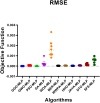Enhancing CO2 emissions prediction for electric vehicles using Greylag Goose Optimization and machine learning
- PMID: 40360691
- PMCID: PMC12075672
- DOI: 10.1038/s41598-025-99472-0
Enhancing CO2 emissions prediction for electric vehicles using Greylag Goose Optimization and machine learning
Abstract
Electric vehicle (EV) [Formula: see text] emissions should be predicted and mitigated, which requires lowering EV emissions in line with global sustainability goals. Such accurate forecasting supports policymakers and other industry stakeholders make marketing decisions to reduce environmental impacts and optimize resource utilization. In this research, a novel Greylag Goose Optimization (GGO) algorithm is integrated with a Multi-Layer Perceptron (MLP) model to improve [Formula: see text] emissions prediction. Finally, the study does a comparative analysis with some established optimization algorithms in hyperparameter tuning regarding an improved accuracy model. In addition, statistical analyses such as ANOVA, sensitivity analysis, and T-test were used to substantiate performance differentiation between models. For the optimal model, the GGO-optimized MLP significantly outperformed baseline models and other optimization techniques, having minimum error metrics such as correlation coefficient and RMSE and an MSE of [Formula: see text]. As a result, the emissions forecast is very reliable. The proposed approach provides actionable insights for environmental policies, EV adoption strategies, and infrastructure planning. The model enables stakeholders to achieve climate objectives, optimize EV charging systems and foster the creation of sustainable transportation systems, as said accurate emissions estimates are enabled.
Keywords: [Formula: see text] emissions prediction; Electric vehicles (EVs); Greylag Goose Optimization (GGO); Multi-Layer Perceptron (MLP); Sustainable transportation.
© 2025. The Author(s).
Conflict of interest statement
Declarations. Competing interests: The authors declare no competing interests.
Figures






















Similar articles
-
Enhancing hosting capacity for electric vehicles in modern power networks using improved hybrid optimization approaches with environmental sustainability considerations.Sci Rep. 2024 Oct 27;14(1):25607. doi: 10.1038/s41598-024-76410-0. Sci Rep. 2024. PMID: 39463435 Free PMC article.
-
Greylag goose optimization and multilayer perceptron for enhancing lung cancer classification.Sci Rep. 2024 Oct 10;14(1):23784. doi: 10.1038/s41598-024-72013-x. Sci Rep. 2024. PMID: 39390014 Free PMC article.
-
Deep learning model based prediction of vehicle CO2 emissions with eXplainable AI integration for sustainable environment.Sci Rep. 2025 Jan 29;15(1):3655. doi: 10.1038/s41598-025-87233-y. Sci Rep. 2025. PMID: 39880869 Free PMC article.
-
Review of Building Integrated Photovoltaics System for Electric Vehicle Charging.Chem Rec. 2024 Mar;24(3):e202300308. doi: 10.1002/tcr.202300308. Epub 2024 Jan 10. Chem Rec. 2024. PMID: 38200590 Review.
-
Electric vehicles in transition: Opportunities, challenges, and research agenda - A systematic literature review.J Environ Manage. 2024 Dec;372:123415. doi: 10.1016/j.jenvman.2024.123415. Epub 2024 Nov 24. J Environ Manage. 2024. PMID: 39581008
Cited by
-
Optimizing electric vehicle energy consumption prediction through machine learning and ensemble approaches.Sci Rep. 2025 Aug 8;15(1):29065. doi: 10.1038/s41598-025-14129-2. Sci Rep. 2025. PMID: 40781262 Free PMC article.
-
Novel Greylag Goose Optimization Algorithm with Evolutionary Game Theory (EGGO).Biomimetics (Basel). 2025 Aug 19;10(8):545. doi: 10.3390/biomimetics10080545. Biomimetics (Basel). 2025. PMID: 40862917 Free PMC article.
References
-
-
Aras, S. & Van Hanifi, M. An interpretable forecasting framework for energy consumption and
 emissions. Appl. Energy328, 120163. 10.1016/j.apenergy.2022.120163 (2022).
emissions. Appl. Energy328, 120163. 10.1016/j.apenergy.2022.120163 (2022).
-
Aras, S. & Van Hanifi, M. An interpretable forecasting framework for energy consumption and
-
-
Xu, B., Sharif, A., Shahbaz, M. & Dong, K. Have electric vehicles effectively addressed
 emissions? Analysis of eight leading countries using quantile-on-quantile regression approach. Sustain. Prod. Consum.27, 1205–1214. 10.1016/j.spc.2021.03.002 (2021).
emissions? Analysis of eight leading countries using quantile-on-quantile regression approach. Sustain. Prod. Consum.27, 1205–1214. 10.1016/j.spc.2021.03.002 (2021).
-
Xu, B., Sharif, A., Shahbaz, M. & Dong, K. Have electric vehicles effectively addressed
-
-
Delanoë, P., Tchuente, D. & Colin, G. Method and evaluations of the effective gain of artificial intelligence models for reducing
 emissions. J. Environ. Manag.331, 117261. 10.1016/j.jenvman.2023.117261 (2023).
-
PubMed
emissions. J. Environ. Manag.331, 117261. 10.1016/j.jenvman.2023.117261 (2023).
-
PubMed
-
Delanoë, P., Tchuente, D. & Colin, G. Method and evaluations of the effective gain of artificial intelligence models for reducing
-
-
Butt, M. H. & Singh, J. G. Factors affecting electric vehicle acceptance, energy demand and
 emissions in Pakistan. Green Energy Intell. Transp.2, 100081. 10.1016/j.geits.2023.100081 (2023).
emissions in Pakistan. Green Energy Intell. Transp.2, 100081. 10.1016/j.geits.2023.100081 (2023).
-
Butt, M. H. & Singh, J. G. Factors affecting electric vehicle acceptance, energy demand and
-
- Ahmed, M., Mao, Z., Zheng, Y., Chen, T. & Chen, Z. Electric vehicle range estimation using regression techniques. World Electr. Veh. J.10.3390/wevj13060105 (2022).
LinkOut - more resources
Full Text Sources
Research Materials

